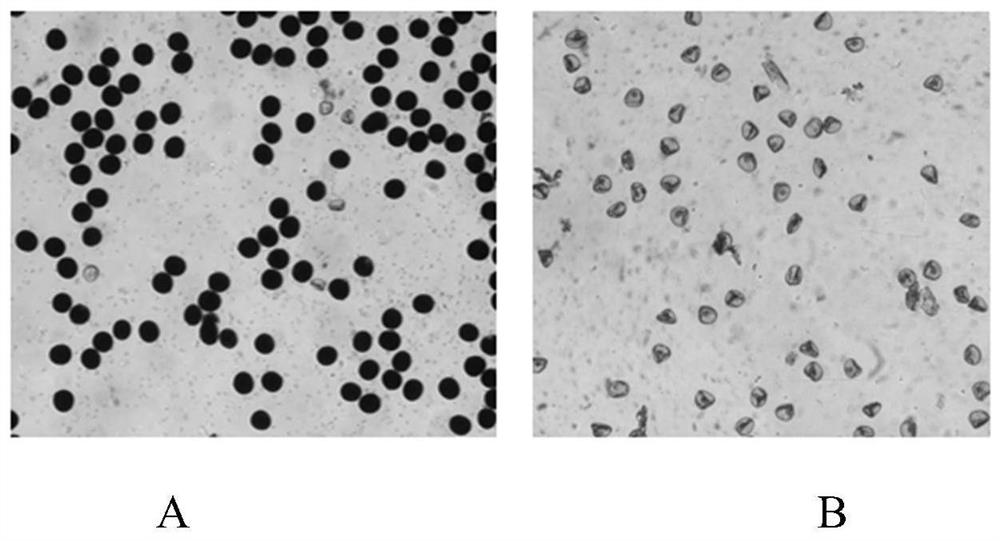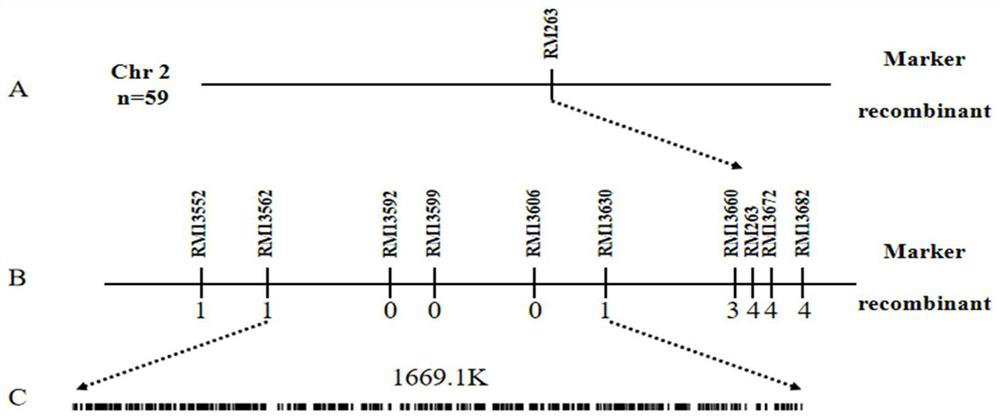Molecular marker related to rice nucleus male sterility phenotype and application
A molecular marker and male sterility technology, applied in the field of plant molecular biology, can solve the problems of high risk of seed production, fertility affected by light and temperature environment, and geographical restrictions of seed production, so as to improve the breeding efficiency, efficient and accurate screening and other problems. The effect of detection
- Summary
- Abstract
- Description
- Claims
- Application Information
AI Technical Summary
Problems solved by technology
Method used
Image
Examples
Embodiment 1
[0054] Example 1 Phenotype and genetic analysis of rice nuclear male sterile mutant gms4372
[0055] 1) Screening of gms4372 mutants
[0056] In June 2013, 10 kg of 93-11 seeds were irradiated with cobalt 60 to obtain the M0 generation. The irradiated seeds were planted in the experimental field of Lingao County, Hainan Province, and harvested by individual plants after maturity. A total of about 6,500 M1 generation materials were obtained. In the spring of 2014, 3617 M1 generation materials with a large amount of seeds were selected and planted into strains, and 50 individual plants were planted in each strain. Various types of mutants such as plant type, panicle type, fertility, yield, etc. were screened at the tillering stage, booting stage, heading stage, flowering stage, and grain filling stage, and harvested and stored. In family No. 4372, a mutant was found to be male sterile, and it was named gms4372.
[0057] 2) Phenotype analysis of gms4372 mutant
[0058] Under ...
Embodiment 2
[0061] Example 2 Preliminary Mapping of the Male Sterility Gene GMS4372
[0062] The GMS4372 gene was mapped using bulked segregant analysis and recessive-class analysis for extreme traits. A F2 population was constructed by crossing Minghui 63 with the gms4372 mutant, and 59 sterile plants were isolated. Using 301 pairs of SSR markers evenly distributed on 12 chromosomes to screen polymorphic markers between 93-11 and Minghui 63, 64 pairs of polymorphic SSR markers were screened, and the polymorphism was low, indicating that The genome sequences of Hui 63 and 93-11 were slightly different. The mixed gene pools of the fertile and sterile plants of the F2 population were respectively constructed, and the fertile gene pool and the sterile gene pool were analyzed by using the 64 pairs of polymorphic markers. The results showed that there was a linkage relationship between the SSR marker RM263 on chromosome 2 and the mutant phenotype of gms4372. The genotypes of the sterile str...
Embodiment 3
[0066] Example 3 Polymorphisms of RM13592, RM13599 and RM13606 in Different Varieties
[0067] In order to verify the specificity of the three markers RM13592, RM13599 and RM13606 in indicating the male sterility phenotype of the gms4372 mutant, the polymorphisms of the three markers in multiple varieties were analyzed, wherein RM13592 consists of SEQ ID NO.1-2 The primers shown are amplified, RM13599 is amplified by the primers shown in SEQ ID NO.3-4, and RM13606 is amplified by the primers shown in SEQ ID NO.5-6. Figure 6 Swimming lanes 1-10 show that RM13592 amplified bands of 105 bp different from the size of the parent gms4372 in other parents, except for the 105 bp bands amplified in gms4372, H28B, Q3B, Zhongzhe B and Wufeng B. Figure 6 Lanes 11-19 show that in the F1 hybrids of gms4372 and other parents, in addition to the above-mentioned H28B, Q3B, Zhongzhe B and Wufeng B donors, the bands of two parents can be amplified simultaneously with other parents, indicating ...
PUM
 Login to View More
Login to View More Abstract
Description
Claims
Application Information
 Login to View More
Login to View More - R&D
- Intellectual Property
- Life Sciences
- Materials
- Tech Scout
- Unparalleled Data Quality
- Higher Quality Content
- 60% Fewer Hallucinations
Browse by: Latest US Patents, China's latest patents, Technical Efficacy Thesaurus, Application Domain, Technology Topic, Popular Technical Reports.
© 2025 PatSnap. All rights reserved.Legal|Privacy policy|Modern Slavery Act Transparency Statement|Sitemap|About US| Contact US: help@patsnap.com



